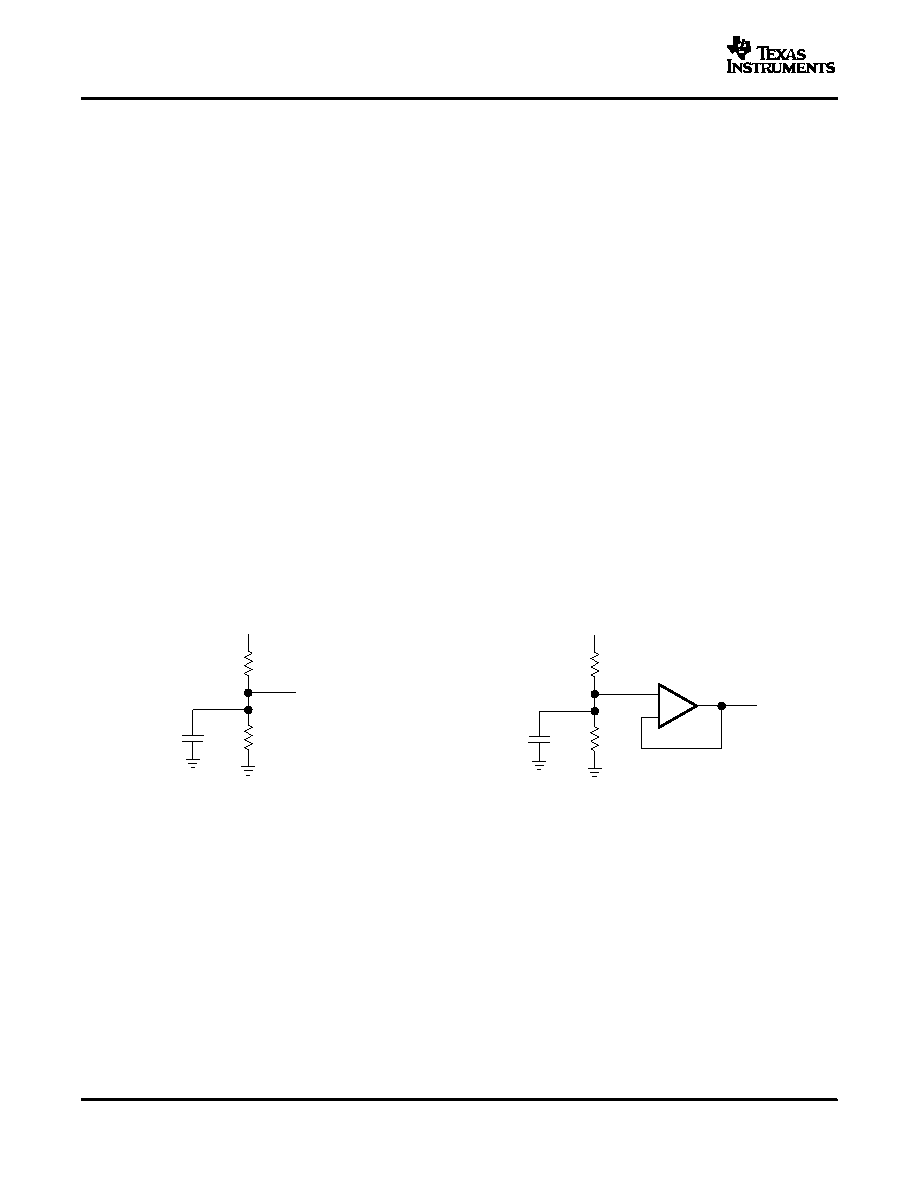- 您現(xiàn)在的位置:買賣IC網(wǎng) > PDF目錄98269 > TPA112DG4 (TEXAS INSTRUMENTS INC) 0.07 W, 2 CHANNEL, AUDIO AMPLIFIER, PDSO8 PDF資料下載
參數(shù)資料
| 型號(hào): | TPA112DG4 |
| 廠商: | TEXAS INSTRUMENTS INC |
| 元件分類: | 音頻/視頻放大 |
| 英文描述: | 0.07 W, 2 CHANNEL, AUDIO AMPLIFIER, PDSO8 |
| 封裝: | GREEN, PLASTIC, MS-012AA, SOIC-8 |
| 文件頁(yè)數(shù): | 13/29頁(yè) |
| 文件大小: | 707K |
| 代理商: | TPA112DG4 |
第1頁(yè)第2頁(yè)第3頁(yè)第4頁(yè)第5頁(yè)第6頁(yè)第7頁(yè)第8頁(yè)第9頁(yè)第10頁(yè)第11頁(yè)第12頁(yè)當(dāng)前第13頁(yè)第14頁(yè)第15頁(yè)第16頁(yè)第17頁(yè)第18頁(yè)第19頁(yè)第20頁(yè)第21頁(yè)第22頁(yè)第23頁(yè)第24頁(yè)第25頁(yè)第26頁(yè)第27頁(yè)第28頁(yè)第29頁(yè)

www.ti.com
POWER SUPPLY DECOUPLING, CS
MIDRAIL VOLTAGE
_
+
VDD
R
Midrail
CBYPASS
VDD
R
Midrail
CBYPASS
TLV2460
a) Midrail Voltage Generator Using a Simple
Resistor-Divider
b) Buffered Midrail Voltage Generator to Provide
Low Output Impedance
TPA112
SLOS212E – AUGUST 1998 – REVISED JUNE 2004
APPLICATION INFORMATION (continued)
The TPA112 is a high-performance CMOS audio amplifier that requires adequate power supply decoupling to
ensure that the output total harmonic distortion (THD) is as low as possible. Power supply decoupling also
prevents oscillations for long lead lengths between the amplifier and the speaker. The optimum decoupling is
achieved by using two capacitors of different types that target different types of noise on the power supply leads.
For higher frequency transients, spikes, or digital hash on the line, a good low equivalent-series-resistance (ESR)
ceramic capacitor; typically, 0.1 F, placed as close as possible to the device VDD lead, works best. For filtering
lower frequency noise signals, a larger aluminum electrolytic capacitor of 10 F or greater placed near the power
amplifier is recommended.
The TPA112 is a single-supply amplifier; so, it must be properly biased to accommodate audio signals. Normally,
the amplifier is biased at VDD/2, but it can actually be biased at any voltage between VDD and ground. However,
biasing the amplifier at a point other than VDD/2 reduces the amplifier's maximum output swing. In some
applications where the circuitry driving the TPA112 has a different midrail voltage, it might make sense to use the
same midrail voltage for the TPA112, and possibly eliminate the use of the dc-blocking capacitors.
The two concerns with the midrail voltage source are the amount of noise present and its output impedance. Any
noise present on the midrail voltage source that is not present on the audio input signal will be input to the
amplifier, and passed to the output (and increased by the gain of the circuit). Common-mode noise is cancelled
out by the differential configuration of the circuit.
The output impedance of the circuit used to generate the midrail voltage needs to be low enough so as not to be
influenced by the audio signal path. A common method of generating the midrail voltage is to form a voltage
divider from the supply to ground, with a bypass capacitor from the common node to ground. This capacitor
improves the PSRR of the circuit. However, this circuit has a limited range of output impedances; so, to achieve
low output impedances, the voltage generated by the voltage divider is fed into a unity-gain amplifier to lower the
output impedance of the circuit.
Figure 47. Midrail Voltage Generator
If a voltage step is applied to a speaker, it causes a noise pop. To reduce popping, the midrail voltage should
rise at a subsonic rate. That is, a rate less than the rise time of a 20-Hz waveform. If the voltage rises faster than
that, there is the possibility of a pop from the speaker.
Pop can also be heard in the speaker if the midrail voltage rises faster than the charge of either the input
coupling capacitor or the output coupling capacitor. If midrail rises first, the charging of the input and output
capacitors is heard in the speaker. To keep this noise as low as possible, the relationship shown in Equation 6
should be maintained.
20
相關(guān)PDF資料 |
PDF描述 |
|---|---|
| TPA112DGNG4 | 0.07 W, 2 CHANNEL, AUDIO AMPLIFIER, PDSO8 |
| TPA112DRG4 | 0.07 W, 2 CHANNEL, AUDIO AMPLIFIER, PDSO8 |
| TPA112DGNRG4 | 0.07 W, 2 CHANNEL, AUDIO AMPLIFIER, PDSO8 |
| TPA1517NE | 6 W, 2 CHANNEL, AUDIO AMPLIFIER, PDIP20 |
| TPA1517DWPR | 6 W, 2 CHANNEL, AUDIO AMPLIFIER, PDSO20 |
相關(guān)代理商/技術(shù)參數(shù) |
參數(shù)描述 |
|---|---|
| TPA112DGN | 功能描述:音頻放大器 150mW Stereo RoHS:否 制造商:STMicroelectronics 產(chǎn)品:General Purpose Audio Amplifiers 輸出類型:Digital 輸出功率: THD + 噪聲: 工作電源電壓:3.3 V 電源電流: 最大功率耗散: 最大工作溫度: 安裝風(fēng)格:SMD/SMT 封裝 / 箱體:TQFP-64 封裝:Reel |
| TPA112DGNG4 | 功能描述:音頻放大器 150mW Stereo Aud Power Amp RoHS:否 制造商:STMicroelectronics 產(chǎn)品:General Purpose Audio Amplifiers 輸出類型:Digital 輸出功率: THD + 噪聲: 工作電源電壓:3.3 V 電源電流: 最大功率耗散: 最大工作溫度: 安裝風(fēng)格:SMD/SMT 封裝 / 箱體:TQFP-64 封裝:Reel |
| TPA112DGNR | 功能描述:音頻放大器 150mW Stereo RoHS:否 制造商:STMicroelectronics 產(chǎn)品:General Purpose Audio Amplifiers 輸出類型:Digital 輸出功率: THD + 噪聲: 工作電源電壓:3.3 V 電源電流: 最大功率耗散: 最大工作溫度: 安裝風(fēng)格:SMD/SMT 封裝 / 箱體:TQFP-64 封裝:Reel |
| TPA112DGNRG4 | 功能描述:音頻放大器 150mW Stereo RoHS:否 制造商:STMicroelectronics 產(chǎn)品:General Purpose Audio Amplifiers 輸出類型:Digital 輸出功率: THD + 噪聲: 工作電源電壓:3.3 V 電源電流: 最大功率耗散: 最大工作溫度: 安裝風(fēng)格:SMD/SMT 封裝 / 箱體:TQFP-64 封裝:Reel |
| TPA112DR | 功能描述:音頻放大器 150mW Stereo RoHS:否 制造商:STMicroelectronics 產(chǎn)品:General Purpose Audio Amplifiers 輸出類型:Digital 輸出功率: THD + 噪聲: 工作電源電壓:3.3 V 電源電流: 最大功率耗散: 最大工作溫度: 安裝風(fēng)格:SMD/SMT 封裝 / 箱體:TQFP-64 封裝:Reel |
發(fā)布緊急采購(gòu),3分鐘左右您將得到回復(fù)。
